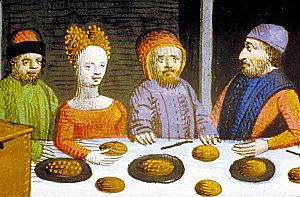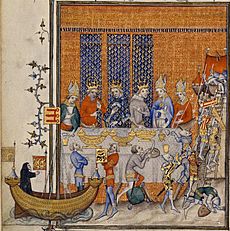Entremet facts for kids
An entremet (say "ahn-truh-MAY") was a special dish served between the main parts of a meal in the past. It comes from an Old French phrase meaning "between servings." Today, an entremet is usually a type of dessert.
Long ago, especially in the Middle Ages, entremets became much more than just food. They turned into amazing entertainment for dinner guests. These could be fancy decorations or even short plays. In England, they were often called subtleties because they were clever and surprising. One famous example was a pie with live blackbirds flying out, which inspired the song "Sing a Song of Sixpence".
Originally, an entremet was a fancy dish served at the end of a course during big banquets. It could be a simple frumenty (a type of wheat porridge) colored brightly with expensive spices. Or it could be a huge model of a castle with tiny wine fountains, musicians, and food shaped into fun scenes.
Contents
History of Entremets
Dishes that were both food and entertainment have a long history. They go back to the early Roman Empire. The Roman writer Petronius described a dish where a rabbit was dressed up to look like Pegasus, a mythical winged horse.
What Entremets Did
The main purpose of an entremet was to mark the end of one part of a banquet. A banquet usually had several "courses," which were servings of different dishes. The entremet helped guests get ready for the next serving. It also gave people something interesting to talk about.
The first known recipe for an entremet is from the early 14th century. It's in a medieval cookbook called Le Viandier. This recipe was for a fairly simple dish. It included boiled and fried chicken liver with spices, wine, and egg yolks. It was meant to be a bright yellow color. Even simpler dishes, like millet boiled in milk with saffron, were also called entremets.
From Food to Art
At first, entremets were all about bright, eye-catching colors. Later, they became "illusion foods." These were dishes that looked like something else. For example, peacocks or swans would be cooked and then put back into their own feathers. Sometimes, they were filled with tastier bird meat!
Other illusion foods showed scenes from everyday life. Imagine a grilled capon (a type of chicken) dressed as a knight with a paper helmet and lance. It would be riding on the back of a roasted piglet! Large models of castles made from food were also very popular. At a feast in 1343 for Pope Clement VI, one entremet was a castle. Its walls were made from roasted birds, and it was filled with cooked deer, wild boar, goat, hare, and rabbit.
Entremets as Performances
In the 14th century, entremets started to include more than just amazing food displays. They became grand, symbolic performances. In 1306, a knighting ceremony for the son of Edward I of England featured songs and stories as part of the entremet.
Over time, these performances became like mini-plays. They had props, actors, singers, and dancers. At a banquet in 1378, Charles V of France honored Charles IV, Holy Roman Emperor. A huge wooden model of the city of Jerusalem was rolled into the hall. Then, actors playing the crusader Godfrey of Bouillon and his knights sailed in on a tiny ship. They acted out the capture of Jerusalem from 1099.
Political Messages in Entremets
Entremets were also a great way to show off political power or send a message. One famous example is the Feast of the Pheasant in 1454. This banquet was arranged by Philip the Good of Burgundy. The theme was the fall of Constantinople to the Ottoman Turks in 1453. Philip and his guests made a promise to retake the city in a crusade. (This crusade never happened.)
This banquet had many spectacular displays called entremets. Guests saw amazing automatons (moving mechanical figures) like fountains and pies with musicians inside. At the end, an actor representing the Holy Church rode in on an elephant. This actor read a poem about the struggles of Christians in Eastern lands under Ottoman rule.
English "Subtleties"
From the late 14th century in England, entremets were called subtleties. This name came from an old meaning of "subtle," which meant "clever" or "surprising." English subtleties did not include actors; those performances were called pageants.
The famous nursery rhyme "Sing a Song of Sixpence" talks about "four and twenty blackbirds baked in a pie." This idea came from an entremet used to entertain guests in the 14th century. An Italian cook from that time described how live birds were put into a baked pie shell through a hole in the bottom. When the top crust was cut, the birds would fly out, surprising everyone!
By the end of the Middle Ages, royal courts in Europe were very refined. Powerful hosts and their rich guests wanted even more complex and amazing creations. Chiquart, a cook for Amadeus VIII, Duke of Savoy, wrote about an entremet called Castle of Love in his 15th-century cookbook.
This "Castle of Love" was a giant castle model with four towers. Four men had to carry it in! Inside the castle, there was a roasted piglet, a swan cooked and put back in its feathers, a roasted boar's head, and a pike fish cooked in three ways without being cut. All these animals seemed to breathe fire! The castle walls had banners of the Duke and his guests, and tiny archers. Inside, a fountain gushed rosewater and spiced wine.
Entremets in Early Modern Times
In the 17th century, these grand banquet events continued to entertain nobles. The Duke of Buckingham hosted a memorable banquet for King Charles I and Queen Henrietta Maria. For this event, a pie was made that hid a human being! It was Jeffrey Hudson, a famous dwarf of that time.
Later, a cookbook writer named Eliza Acton listed many dishes as "second-course dishes" or entremets. These included both sweet and savory foods. There were small fruit-filled pastries, a coconut cheesecake from Jamaica, jam-filled puff pastries, and different kinds of pies. She also listed pan-fried "potato ribbons," various croquettes, and vegetables like sea kale and spinach with gravy. Other dishes included sugar-glazed carrots, poached eggs with sauce, asparagus tips, green peas, green beans with lemon-butter sauce, and turnips. For desserts, there were many sweet puddings, molded "fancy jellies," and cakes.
See also
 In Spanish: Entremés (gastronomía) para niños
In Spanish: Entremés (gastronomía) para niños
|




